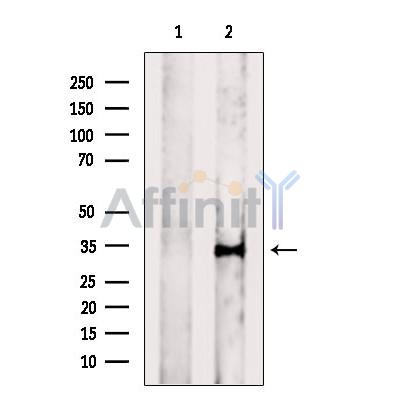ROGDI Antibody - #DF12467
| Product: | ROGDI Antibody |
| Catalog: | DF12467 |
| Description: | Rabbit polyclonal antibody to ROGDI |
| Application: | WB IHC |
| Reactivity: | Human, Mouse, Monkey |
| Prediction: | Pig, Bovine, Horse, Sheep, Rabbit, Dog |
| Mol.Wt.: | 32 kDa; 32kD(Calculated). |
| Uniprot: | Q9GZN7 |
| RRID: | AB_2845272 |
Related Downloads
Protocols
Product Info
*The optimal dilutions should be determined by the end user. For optimal experimental results, antibody reuse is not recommended.
*Tips:
WB: For western blot detection of denatured protein samples. IHC: For immunohistochemical detection of paraffin sections (IHC-p) or frozen sections (IHC-f) of tissue samples. IF/ICC: For immunofluorescence detection of cell samples. ELISA(peptide): For ELISA detection of antigenic peptide.
Cite Format: Affinity Biosciences Cat# DF12467, RRID:AB_2845272.
Fold/Unfold
FLJ22386; KTZS; Leucine zipper domain protein; Protein rogdi homolog; rogdi; rogdi homolog (Drosophila); rogdi, Drosophila, homolog of; ROGDI_HUMAN;
Immunogens
A synthesized peptide derived from human ROGDI, corresponding to a region within the internal amino acids.
Widely expressed with highest levels in spinal cord, brain, heart and bone marrow. Also expressed in fetal brain and liver.
- Q9GZN7 ROGDI_HUMAN:
- Protein BLAST With
- NCBI/
- ExPASy/
- Uniprot
MATVMAATAAERAVLEEEFRWLLHDEVHAVLKQLQDILKEASLRFTLPGSGTEGPAKQENFILGSCGTDQVKGVLTLQGDALSQADVNLKMPRNNQLLHFAFREDKQWKLQQIQDARNHVSQAIYLLTSRDQSYQFKTGAEVLKLMDAVMLQLTRARNRLTTPATLTLPEIAASGLTRMFAPALPSDLLVNVYINLNKLCLTVYQLHALQPNSTKNFRPAGGAVLHSPGAMFEWGSQRLEVSHVHKVECVIPWLNDALVYFTVSLQLCQQLKDKISVFSSYWSYRPF
Predictions
Score>80(red) has high confidence and is suggested to be used for WB detection. *The prediction model is mainly based on the alignment of immunogen sequences, the results are for reference only, not as the basis of quality assurance.
High(score>80) Medium(80>score>50) Low(score<50) No confidence
Research Backgrounds
Nucleus envelope. Cell junction>Synapse>Presynapse. Cell projection>Axon. Perikaryon. Cell projection>Dendrite. Cytoplasmic vesicle>Secretory vesicle>Synaptic vesicle.
Note: Detected primarily at presynaptic sites on axons, and to a lesser degree in soma and dendrites. Not detected at post-synaptic sites.
Widely expressed with highest levels in spinal cord, brain, heart and bone marrow. Also expressed in fetal brain and liver.
Belongs to the rogdi family.
Restrictive clause
Affinity Biosciences tests all products strictly. Citations are provided as a resource for additional applications that have not been validated by Affinity Biosciences. Please choose the appropriate format for each application and consult Materials and Methods sections for additional details about the use of any product in these publications.
For Research Use Only.
Not for use in diagnostic or therapeutic procedures. Not for resale. Not for distribution without written consent. Affinity Biosciences will not be held responsible for patent infringement or other violations that may occur with the use of our products. Affinity Biosciences, Affinity Biosciences Logo and all other trademarks are the property of Affinity Biosciences LTD.
